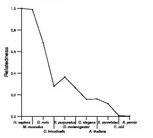
| Name: PUM1 | Sequence: fasta or formatted (1186aa) | NCBI GI: 13491166 | |
|
Description: pumilio 1 isoform 2
|
Referenced in: Small RNAs in RNA Processing
| ||
Other entries for this name:
alt prot [1188aa] pumilio 1 isoform 1 | |||
|
Composition:

Amino acid Percentage Count Longest homopolymer A alanine 9.9 117 7 C cysteine 1.0 12 1 D aspartate 4.4 52 2 E glutamate 4.0 47 2 F phenylalanine 3.3 39 2 G glycine 9.8 116 4 H histidine 3.0 35 2 I isoleucine 3.2 38 2 K lysine 3.5 41 2 L leucine 8.3 99 2 M methionine 2.1 25 2 N asparagine 5.1 60 3 P proline 6.7 80 3 Q glutamine 8.3 98 4 R arginine 4.0 47 2 S serine 9.9 117 4 T threonine 4.0 47 2 V valine 6.4 76 2 W tryptophan 0.5 6 1 Y tyrosine 2.9 34 2 |
Comparative genomics:
Search single species RefSeq proteins at NCBI
Search summary 
Figure data | ||
Related human proteins:Protein Relative score Description Self-match 1.000 pumilio 1 isoform 2 PUM1 0.998 pumilio 1 isoform 1 PUM2 0.672 pumilio homolog 2 KIAA0020 0.020 KIAA0020 protein HRNR 0.017 hornerin C14orf4 0.013 chromosome 14 open reading frame 4 NUP214 0.012 nucleoporin 214kDa MED1 0.011 mediator complex subunit 1 DMKN 0.011 dermokine isoform 2 precursor ZFR 0.011 zinc finger RNA binding protein SRRM2 0.010 splicing coactivator subunit SRm300 CDSN 0.010 corneodesmosin precursor CDC2L5 0.010 cell division cycle 2-like 5 isoform 1 CDC2L5 0.010 cell division cycle 2-like 5 isoform 2 NUP153 0.010 nucleoporin 153kDa MUC21 0.010 mucin 21 DMKN 0.010 dermokine isoform 4 precursor DMKN 0.010 dermokine isoform 5 precursor DMKN 0.010 dermokine isoform 3 precursor POM121 0.010 nuclear pore membrane protein 121 NUP98 0.009 nucleoporin 98kD isoform 3 MUC12 0.009 PREDICTED: mucin 12 SPAG8 0.008 sperm associated antigen 8 isoform 1 ARID1B 0.008 AT rich interactive domain 1B (SWI1-like) isoform 2 ... ARID1B 0.008 AT rich interactive domain 1B (SWI1-like) isoform 3 ... SPAG8 0.008 sperm associated antigen 8 isoform 2 NUP98 0.008 nucleoporin 98kD isoform 4 NUP98 0.008 nucleoporin 98kD isoform 1 NUP98 0.008 nucleoporin 98kD isoform 2 NAV2 0.008 neuron navigator 2 isoform 4Human BLASTP results (used to prepare the table) | |||
Gene descriptions are from NCBI RefSeq. Search results were obtained with NCBI BLAST and RefSeq entries. When identical proteins are present, the self-match may not be listed first in BLASTP output. In such cases, the table above has been reordered to place it first.
See About the Figures for the scoring system used in the figure above right. The same scoring system was used in the table of BLASTP results.
Guide to the Human Genome
Copyright © 2010 by Stewart Scherer. All rights reserved.
